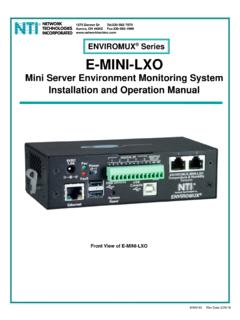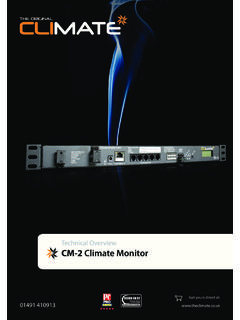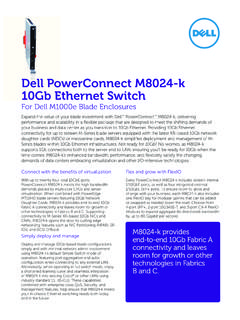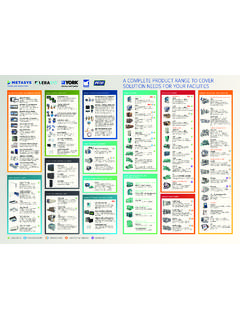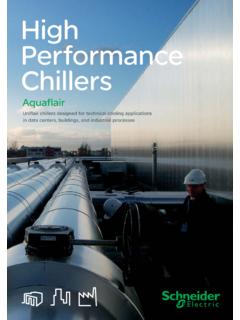Transcription of Lonix IBMS specification 150417
1 IBMS specification Lonix Ltd Finland 1 (23) Lonix LTD Teollisuuskatu 33 Tel. +358 9 349 9853 VAT 1043054-9 FI-00510 Helsinki, Finland Fax +358 9 349 9863 Trade IBMS specification specification & Design Guideline for Integrated Intelligent Building Management System Lonix Ltd IBMS specification Lonix Ltd Finland 2 (23) Lonix LTD Teollisuuskatu 33 Tel. +358 9 349 9853 VAT 1043054-9 FI-00510 Helsinki, Finland Fax +358 9 349 9863 Trade specification for Integrated Intelligent Building Management System INDEX 1 Introduction ..4 2 System Architecture ..4 Overall Architecture of Principles of System Integration ..5 3 Building Automation / Building Management System ..5 General ..5 BMS Controllers ..6 Room Automation and Unit Controllers ..7 Field Temperature Sensors ..8 Relative Humidity Sensors ..8 CO2 Sensors ..9 CO Sensors ..9 Differential Pressure Sensors.
2 9 Air Differential Pressure Switches .. 10 Monitoring & Control Software .. 10 4 Lighting Control System .. 10 General .. 10 Controllers .. 10 Monitoring & Control Software .. 12 5 Access Control & Intruder Alarm System .. 12 General .. 12 Controllers and Interface 13 Network Controller .. 13 Interface Panels .. 13 Field 14 Monitoring & Control Software (Security Management System) .. 14 6 Video Surveillance System .. 14 General .. 14 NVR integration with Monitoring & Control Software .. 14 Cameras .. 15 7 Monitoring & Control Software .. 15 General .. 15 Main Features .. 16 Data Model .. 17 Database .. 17 Operating System .. 17 Standby Server .. 17 Integration Interfaces .. 18 System Interface .. 18 Enterprise Interface .. 18 IBMS specification Lonix Ltd Finland 3 (23) Lonix LTD Teollisuuskatu 33 Tel. +358 9 349 9853 VAT 1043054-9 FI-00510 Helsinki, Finland Fax +358 9 349 9863 Trade 8 User Interfaces.
3 19 General .. 19 Client User Interface Application .. 20 Web User Interface Application .. 20 Graphical Pages .. 20 Alarms .. 21 Trending .. 22 Event Logs .. 22 User Rights Management .. 22 Operator Workstation Hardware .. 23 IBMS specification Lonix Ltd Finland 4 (23) Lonix LTD Teollisuuskatu 33 Tel. +358 9 349 9853 VAT 1043054-9 FI-00510 Helsinki, Finland Fax +358 9 349 9863 Trade 1 Introduction What is IBMS? - Why is IBMS an advantage? - Purpose and scope of this document. IBMS stands for Integrated Building Management System . An Integrated Building Management System is a single, comprehensive building management system for HVAC, lighting, security, fire and other systems. The Building Management System (BMS) can be defined as the system installed in buildings that controls and monitors the building s mechanical and electrical equipment, such as heating, cooling, ventilation, and lighting.
4 These systems typically represent 70% of a building's energy usage. Obviously, the role of BMS is crucial in management of the building s energy demand. Beyond controlling the internal environment of the building, the IBMS ( Integrated Building Management System ) covers also access control, intruder alarms, video surveillance, monitoring of fire alarm system and other systems as applicable. IBMS can be referred to as the Integrated BMS and Security System; the single, uniform system for building management. Application of full IBMS brings the benefits of better indoor comfort, energy efficiency, safety and security, and most importantly, better management of all the systems under the unified system. IBMS supports efficient functional system integration and provides maximum flexibility to support any future changes in the building use. This document describes the essentials of IBMS comprising the following elements: - Building Automation System (BMS) - Lighting Control System - Access Control & Intruder Alarm System - Video Surveillance System - Monitoring & Control Software: The Building Operating System (BOS), providing the comprehensive monitoring & integration platform for IBMS 2 System Architecture Overall Architecture of IBMS The Integrated Building Management System (IBMS) shall incorporate industry standard operating systems, communication networks and protocols.
5 The system shall be designed to be completely modular in structure and freely expandable at any stage. To ensure fault tolerant operation and robust system design, the system shall incorporate distributed control techniques and apply principles of distributed intelligence whenever applicable. IBMS specification Lonix Ltd Finland 5 (23) Lonix LTD Teollisuuskatu 33 Tel. +358 9 349 9853 VAT 1043054-9 FI-00510 Helsinki, Finland Fax +358 9 349 9863 Trade The overall system architecture comprises the following logical layers: - Management Layer for system monitoring and management - Control Layer for intelligence of the system - Field Layer for industry standard sensors, actuators, peripherals etc. Each layer of the system shall operate independently of the next level up, in order to allow for fault tolerant system functionality. Most importantly, the Control Layer shall operate independently without support from the Management Layer.
6 It shall be possible to integrate BMS systems with security systems as specified in this document. The system shall enable remote monitoring, connectivity and value-adding services. The system shall incorporate integrated BMS and Security Systems as described in this document. Principles of System Integration To create comprehensive IBMS and to provide uniform view to all systems, the monitoring & control software shall utilize the generic Building Operating System (BOS) platform that supports integration and interoperability of building systems. Sub-systems to be monitored shall be integrated on software level through the Building Operating System (BOS) platform. The Building Operating System (BOS) expands through drivers to existing and future industry standard protocols, including BACnet, LonWorks, Modbus, M-Bus, OPC, Ethernet TCP/IP and Internet communication technologies.
7 3 Building Automation / Building Management System General Building Automation System (BAS/BMS) comprises the control and monitoring functionality of mechanical (heating, ventilation and air conditioning) and electrical systems in a building. The core functionality of Building Automation keeps the building climate within a specified range, provides lighting based on schedule and/or occupancy, monitors system performance and device failures, and provides notifications to building engineering staff. The typical scope of BAS/BMS contains control and monitoring of mechanical and electrical systems, including cooling/heating system, ventilation system, pumps, tanks, lifts, lighting controls and often also consumption metering. To achieve full benefits of functionally integrated BMS, the Lighting Control System shall be implemented as part of Building Automation / Building Management System, using smart controllers that shall be connected to the same field bus as BMS controllers.
8 IBMS specification Lonix Ltd Finland 6 (23) Lonix LTD Teollisuuskatu 33 Tel. +358 9 349 9853 VAT 1043054-9 FI-00510 Helsinki, Finland Fax +358 9 349 9863 Trade The BMS controllers and the Unit controllers shall be connected to the monitoring and control software through the BOS platform. To create comprehensive IBMS and to provide uniform view to all systems, Building Automation / Building Management System shall be integrated with security and safety systems through the Building Operating System (BOS) platform. BMS Controllers The mechanical and electrical systems shall be controlled and monitored by smart BMS controllers connected to an industry standard field bus. The BMS controllers shall provide for capability of control and monitoring of all mechanical and electrical systems, including cooling/heating system, ventilation system, pumps, tanks, lifts, and lighting controls at the minimum but not limited to above mentioned systems.
9 BMS controllers shall include the full intelligence for system functionality and to be capable of operating independently without interference from any master controllers or management applications. BMS controllers shall support distributed intelligence and centralized system designs alike. It shall be possible to distribute BMS controllers at electrical switchboards or cabinets close to the controlled system to minimize cabling. To achieve better fault tolerance and robust functionality, systems with centralized master/zone controllers shall not be accepted. Each controller shall be capable to function in a stand-alone manner and able to communicate with other controllers without any master controllers. Each BMS controller shall contain a 32-bit processor and standard field bus connectivity. Communication between BMS controllers shall be event based, peer-to-peer real time communication.
10 The field bus topology shall be flexible supporting at least bus, star and free topologies. Any failure problem in communication bus should not affect the operation of the controller. BMS controllers shall be capable of using both 24 VAC and 24 VDC as operating voltage. BMS controllers shall support user friendly operation and maintenance by having clearly visible LED:s in the front panel to indicate status of the controller and status of its I/O points. Each BMS controller involved in process controls shall contain flexible I/O points (each controller including a set of universal inputs and outputs, optimally 10 I/O in each) with freely configurable software functions. Each controller shall be capable of handling I/O point belonging to different systems to enable flexible distribution of I/O points throughout the whole system. The I/O points shall support the following features.


